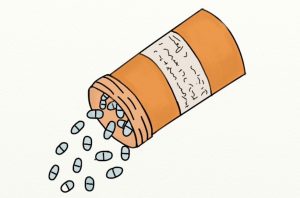Lack of price controls are killing drug innovation
February 24, 2019
Pharmaceutical companies are trading self-interest for the needs of the people, which goes against everything the healthcare industry is meant to stand for. Not only do profit-focused “big pharma” companies, which have skyrocketed their prices recently, disincentivize many low-income buyers from getting the access they need, but they waste resources on drugs that are not innovative. Pharmaceutical companies often sacrifice morality for elusive higher profits.
One of the major components used to justify the lack of pricing controls is the decrease in innovation they would bring. However, this is a flawed assumption. In the current economy, the phenomenon of “me-too drugs,” which are slightly modified chemical versions of the current drugs, are not fostering adequate innovation; they are wasting money. While industries justify this by saying their production is increasing the efficacy of drugs, the production of these similar drugs is taking away from the innovation that could be fostered in the status quo.
According to the European Observatory on Health Systems, 85-90% of developed drugs have little to no benefit for their patients. Price controls are key to checking this. Making selective funding would prevent drug companies from wasting money on drugs that fail to advance current drugs. The production of me-too drugs would be halted in order for companies to invest in creating new novel formulas in the field. The tradeoff between the monetary value gained from extremely high prices would at the worst make pharmaceutical companies be selective about their innovation.
One of the most prominent examples of why price controls do not drastically decrease the budget or disincentivize innovation is Columbia. A report from BMC described that, in 2011 Columbia, a country with an economy reliant on their drug sector, implemented price controls on pharmaceutical drugs. The result was a massive success, according to the Journal on Resource Allocation, Columbia’s economy boomed. Not only did price inflation decrease by 43%, which benefited the value of Columbian currency, but it also more than doubled the profit drug companies made due to increased access. Price controls are not a detriment to innovation, but create increased funding for pharmaceutical companies to innovate.
Another example of this is the majority of Europe which has implemented price controls and seen no change in their economic state. The American Journal of Managed Care described the drastic reductions which had decreases ranging from 7-24% lower prices. These lower prices forced many drug companies to be selective and refine their drug production. “Reference prices” known as a stable price assigned to a group of drugs became the standard for drug prices. Individual companies have the choice to raise those prices, but it’s up to the consumer if they want to make that purchase. However, after instituting price controls, Europe saw no shortage in innovation as many believe, but instead steady growth of innovation.
Increased access to drugs after price controls are implemented is the only moral option in our society. Right now, when purchasing drugs, those with low incomes are either forced to search for the least costly option or are forced to not get the drug access they need in the first place. The extremely high pricing rates mean that many sacrifice their health because pricing is not accessible. The National Center for Health Statistics cites that around 8% of adults who actively need prescription medication cannot afford to purchase these important drugs and risk their health and safety.
Not only is this ethically wrong, but it is also hurting the economic state of the pharmaceutical industry. A massive portion of the population is not investing in medication, a number that would substantially decrease if prices were lower. The logic behind profits decreasing is first, not supported by fact and second, fails to account for the sheer number of people that would be able to contribute to the drug sector if they had access. This increase in economic profit is further reasoning to explain why innovation would still be able to increase if price controls were implemented in the U.S. Columbia and Europe are proof that price controls can be some of the most effective ways to increase accessibility and innovation of the pharmaceutical industry.



Chris Rofidal • Feb 24, 2019 at 7:36 pm
Both perspectives touch only on the pharmaceutical companies role in drug pricing. I felt the both pieces are very well researched, however there are multiple stakeholders to be held accountable for responsible drug pricing..not just the innovating drug companies…